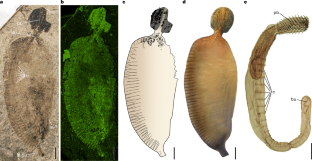2025-04-10 中国科学院(CAS)
<関連情報>
- https://english.cas.cn/newsroom/research_news/earth/202503/t20250321_908472.shtml
- https://www.nature.com/articles/s41586-025-08830-5
ジュラ紀のアカントセファランが棘頭虫の起源を照らし出す A Jurassic acanthocephalan illuminates the origin of thorny-headed worms
Cihang Luo,Luke A. Parry,Brendon E. Boudinot,Shengyu Wang,Edmund A. Jarzembowski,Haichun Zhang & Bo Wang
Nature Published:09 April 2025
DOI:https://doi.org/10.1038/s41586-025-08830-5

Abstract
Acanthocephala (thorny-headed worms), characterized by the presence of an eversible proboscis with hooks, are a diverse endoparasitic group that infect a wide range of vertebrates and invertebrates1. Although long regarded as a separate phylum, they have several putative sister taxa based on morphological features, including Platyhelminthes (flatworms)2, Priapulida (penis worms)3 and Rotifera (wheel animals)4. Molecular phylogenies have instead recovered them within rotifers5,6,7,8,9,10, suggesting acanthocephalans are derived from free-living worms with a jaw apparatus (Gnathifera). Their only fossil record is Late Cretaceous eggs11, contributing limited palaeontological information to deciphering their early evolution. Here we describe an acanthocephalan body fossil, Juracanthocephalus daohugouensis gen. et. sp. nov., from the Middle Jurassic Daohugou biota of China. Juracanthocephalus shows unambiguous acanthocephalan characteristics, for example a hooked proboscis, a bursa, as well as a jaw apparatus with discrete elements that is typical of other gnathiferans. Juracanthocephalus shares features with Seisonidea (an epizoic member of Rotifera) and Acanthocephala, bridging the evolutionary gap between jawed rotifers and the obligate parasitic, jawless acanthocephalans. Our results reveal previously unrecognized ecological and morphological diversity in ancient Acanthocephala and highlight the significance of transitional fossils, revealing the origins of this highly enigmatic group of living organisms.


